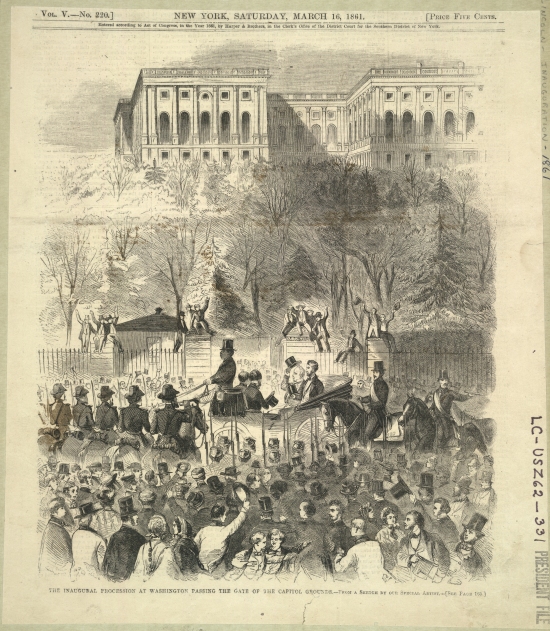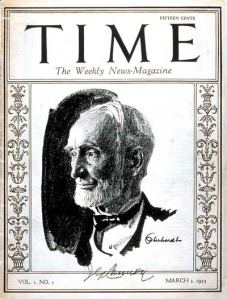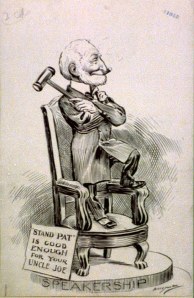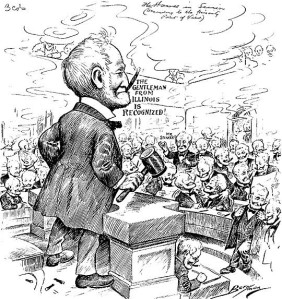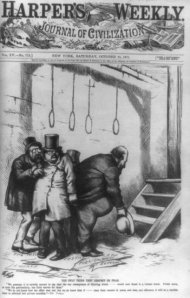— Portrait: Abraham Lincoln’s inauguration, March 1861
December 14, 2010 at 4:33 pm | Posted in -- Harpers Weekly, -- Inauguration: Portraits, -- PRESIDENTS, Abraham Lincoln, Civil War | Leave a commentAbraham Lincoln had little time to celebrate his inauguration as President of the United States on March 4, 1861. Already since his election the prior November, his country had crumbled. Seven states had seceded to form the Confederate States of America and inaugurated Jefferson Davis their president. War seemed likely. Lincoln himself literally had to sneak into Washington to avoid assassination plots. Soldiers guarded his every move. His former law partner Billy Herndon described Lincoln that day as “filled with gloomy forebodings of the future.”
Still, thirty thousand well wishers crammed into Washington for the swearing in that day. After a damp and cold morning, the sun broke through by the time Lincoln reached Capitol Hill. His inaugural speech, which he read while standing beneath the unfinished Capitol Dome, would be among his finest, and both the ceremony and the ball that night went off without a hitch.
The drawing here, a full-page panorama from Harper’s Weekly, shows Lincoln and outgoing President James Buchanan riding together to the ceremony, just reaching the foot of Capitol Hill. Buchanan tips his hat to the crowd. Click on the image to see it full size. Notice the double row of soldiers with bayonets lining the route, the cavalrymen leading the carriage. One soldier on a horse just behind the carriage holds a spyglass toward the crowd. Not seen here are the sharpshooters stationed in nearby windows and on rooftops, the soldiers patrolling side streets, and the additional infantrymen marching behind — all in case of trouble.
The pomp and ceremony seem so normal in this image, and give little sign of the carnage to come. Within a few months, war would come and, before it was over, over 600,000 soldiers North and South would die and countless thousands more would be crippled or maimed for life. But on this day, the transfer of power went smoothly, crowds could still cheer, politicians could still wave their hats, and people could still be happy.
— Portraits: James A. Garfield’s inaugural ball, March 1881
December 12, 2010 at 7:10 pm | Posted in -- CARTOONS AND CARTOONISTS, -- Inauguration: Portraits, -- Leslie's Illustrated, -- PRESIDENTS, Chester Alan Arthur, James G. Blaine, James Garfield, Roscoe Conkling | Leave a comment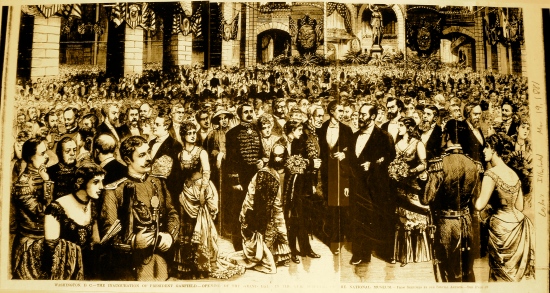 Here’s a snapshot I took recently of a rarely seen two-page spread from the Leslie’s Illustrated of March 19, 1881. It took a team of artists to sketch and then carve it by hand onto wooden block for printing. It shows the grand inaugural ball for President James A. Garfield, held in the Smithsonian Building that year. Garfield, a popular and moderate Ohio Republican, was doomed to serve only four months in office before a psychopathic hanger-on named Charles Guiteau shot him in the back as Garfield was entering the Washington, D.C. train station on a Saturday morning that July. Garfield would die from infection (yes, the doctors killed him by failing to wash their hands) a few months later on September 19, 1881. His assassination would shock the nation and make Garfield widely popular for a generation. There is hardly a town or city in America with a Garfield Street or two.
Here’s a snapshot I took recently of a rarely seen two-page spread from the Leslie’s Illustrated of March 19, 1881. It took a team of artists to sketch and then carve it by hand onto wooden block for printing. It shows the grand inaugural ball for President James A. Garfield, held in the Smithsonian Building that year. Garfield, a popular and moderate Ohio Republican, was doomed to serve only four months in office before a psychopathic hanger-on named Charles Guiteau shot him in the back as Garfield was entering the Washington, D.C. train station on a Saturday morning that July. Garfield would die from infection (yes, the doctors killed him by failing to wash their hands) a few months later on September 19, 1881. His assassination would shock the nation and make Garfield widely popular for a generation. There is hardly a town or city in America with a Garfield Street or two.
Click on the photo to blow it up and marvel at the detail. So accurate is the sketch that you can make out literally dozens of prominent faces in the crowd: Garfield, his wife Lucretia, Senators Roscoe Conkling, John Sherman, and Carl Schurz, plus incoming Vice President Chester Alan Arthur, incoming Secretary of State James G. Blaine, and a bevy of foreign diplomats. Look at the women’s gowns, the bunting on the walls, the guarded conversations. The band that night played tunes from the latest Gilbert and Sullivan operetta H.M.S. Pinafore — Garfield’s favorite. — that had premiered in London just two years earlier.
It’s a group portrait of a vanishing generation of politicians taken at a moment of graceful indulgence. Could any photograph or video have captured the moment so well?
— Portraits: President Grant’s inaugural ball, March 1869
December 11, 2010 at 7:02 pm | Posted in -- CARTOONS AND CARTOONISTS, -- Inauguration: Portraits, -- Leslie's Illustrated, James G. Blaine, Ulysses Grant | 2 CommentsTags: James G. Blaine, Ulysses Grant
 I love the way that old 1800s tabloids like Harper’s Weekly, Leslie’s Illustrated, and the others, long before photographs could be copied on newsprint, used artist’s sketches to capture dazzling visual scenes. The process was primitive and tedious by modern standards. Artists literally had to take their pencil drawings and carve them by hand onto wooden block or steel plates for the ink-slathered printing machines. But the results could be breath-taking, the first time many American’s in their lifetimes ever saw the faces of famous people, the insides of well-known buildings, or glimpses of how the other half lived.
I love the way that old 1800s tabloids like Harper’s Weekly, Leslie’s Illustrated, and the others, long before photographs could be copied on newsprint, used artist’s sketches to capture dazzling visual scenes. The process was primitive and tedious by modern standards. Artists literally had to take their pencil drawings and carve them by hand onto wooden block or steel plates for the ink-slathered printing machines. But the results could be breath-taking, the first time many American’s in their lifetimes ever saw the faces of famous people, the insides of well-known buildings, or glimpses of how the other half lived.
Here’s a nice one: A full-page panorama of the great gala inaugural ball thrown for Ulysses Grant, newly elected president of the United States, in the great chandeliered hall of the Treasury Department in March 1869. It appeared in Leslie’s Illustrated on March 20th that year, drawn by a young artist named James E. Taylor who earned his wings sketching battle scenes during the Civil War.
Click on the photo to see it full size. Look at the detail, the faces, the clothes, the room, and imagine the hours of labor it took to capture each line and nuance. The drawing is so accurate that you can make out individual faces in the crowd, not just President Grant and his wife Julia but also House Speaker James G. Blaine (standing behind Mrs. Grant’s shoulder), Senator Carl Schurz (over to the right), and several Civil War generals.
Photographs and videos are fine, but some of these artist sketches are true Pop Art masterpieces. Hope you like it.
Joe Cannon: A Few More Images
November 18, 2010 at 2:23 am | Posted in -- CARTOONS AND CARTOONISTS, Clifford Berryman, Joseph G. Cannon | Leave a commentA few days ago, I mentioned Joseph G. Cannon, Speaker of the US House of Representatives (1903 to 1911), namesake of today’s Cannon House Office Building in Washington, D.C., who served fifty years in Congress (a record back then) and was the only Speaker ever to be stripped of powers in a public revolt on the House floor. For me, part of the appeal of Cannon’s story is that so much of it was captured in images: newspaper cartoons, photographs, campaign posters, and the rest. I thought you might enjoy seeing a few:
First, on the good side, when Cannon finally left Congress in 1923 as 87 year-old elder statesman, Time Magazine put his face on the cover of its first-ever edition.
Here is Joe in his prime as autocratic House Speaker, around 1908. Cannon had a face that cartoonists loved: long, angular, big nose, big ears, white beard, and always the cigar in his teeth. He was tall, lanky, and twitchy, a whirl of motion who swung his awms when he spoke. Cannon was a penny-pinching conservative (“not one cent for scenery”) who believed in “standing pat” — his words — and used his power to block tariff reforms, labor laws, railroad regulation, and the whole Progressive agenda.
How powerful was he? In this front-page Washington Star cartoon by Clifford Berryman, Uncle Joe delights in presiding over a House consising of 390 little clones of himself.
The 1910 revolt to strip Cannon of his powers was a hugh public defeat and embarrassment. Here he is after the fight
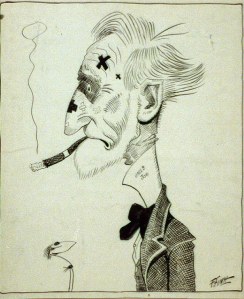
Finally, here is what Joe Cannon actually looked like in 1910. Cannon loved photos like this, with the trademark cigar, the big top havd, and a grin, his eyes betraying no douht about who”s the smarted pertson in the room.
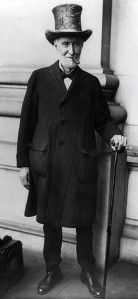
Welcome to America, 1920
March 9, 2010 at 8:57 pm | Posted in Deer Taag, Dutch Schultz, Family History, Jewish Daily Forward, Legs Diamond, Luckuy Luciano, Murder Incorporated, Palmer Raids, Yiddish cartoons | Leave a comment What a country! In America, gangsters controlled the ballot box. Don’t take my word for it. Here’s the featured cartoon in the Jewish Daily Forward from Election Day, November 2, 1920. Republican Warren Harding beat Democrat James Cox that day, but the Forward rejected both of them. It’s candidate was the Socialist, Eugene V. Debs, running his campaign from prison, serving a term for wartime sedition. Debs would get over a million votes.
What a country! In America, gangsters controlled the ballot box. Don’t take my word for it. Here’s the featured cartoon in the Jewish Daily Forward from Election Day, November 2, 1920. Republican Warren Harding beat Democrat James Cox that day, but the Forward rejected both of them. It’s candidate was the Socialist, Eugene V. Debs, running his campaign from prison, serving a term for wartime sedition. Debs would get over a million votes.
November 1920 was also the month that my grandfather landed at Ellis Island, having fled Eastern Europe a step ahead of the law (see prior posts). Having left wife and children behind, he found himself rootless and moniless, stranded in the biggest, freest city on earth — a far cry from backwoods Poland. It would take six years to bring over the rest of the family.
 It wasn’t just politics that must have seemed strange to him. Here’s a cartoon that month from another Yiddish Daily, The Day (Deer Taag). Here, the corrupt goon is the fat, rich landlord squeezing pennies from his impovished slum tenants.
It wasn’t just politics that must have seemed strange to him. Here’s a cartoon that month from another Yiddish Daily, The Day (Deer Taag). Here, the corrupt goon is the fat, rich landlord squeezing pennies from his impovished slum tenants.
Want more goons? Try the police. Earlier in 1920, New York coppers backed by Justice Department agents had rounded up over 5,000 recent immigrants in the notorious Palmer Raids, holding them for weeks on vague charges of disloyalty, deporting almost a thousand, then freeing the rest. “Third degree” tactics were normal back then; “civil liberties” was mostly still just a fancy word on college campuses.
Did I mention organized crime? Let’s see. There were the gangs under Lucky Luciano, Dutch Schultz, and Legs Diamond, not to mention Albert Anastasio and Murder Incorporated over in Brooklyn. And they were just the celebrities.
Want to cross the street? Try walking through this: Driving around New York.
We have built a ridiculously nostalgic image of life for immigrants reaching America in the early Twentieth Century. Don’t be fooled. It was hard, raw, painful, and unforgiving: the back- breaking strain of sweatshop labor, the squalor of tenements, and disdain of the native born. By 1921, “old” Americans grew so hostile against newcomers that they imposed the most restrictive peacetime immigration quotas in history.
Psychologists use a phrase to describe how people can take a painful experience and color their own memory to justify it by turning it into something glorious and honorable — cognitive dissonance. That’s the American immigrant experience.
Economic Stimulus? Bring back Boss Tweed
March 8, 2009 at 11:24 pm | Posted in -- MONEY AND FINANCE, Banks, Boss Tweed, Samuel Tilden, Thomas Nast | Leave a comment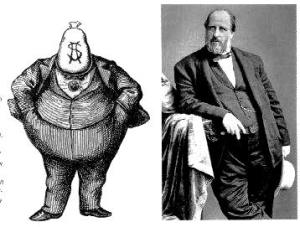 Don’t misunderstand. Stealing is wrong. Graft is bad.
Don’t misunderstand. Stealing is wrong. Graft is bad.
Thomas Nast on Wall Street
March 1, 2009 at 4:42 pm | Posted in Black Friday, James Fisk, Jay Gould, Thomas Nast, Ulysses Grant | Leave a commentRacist Cartoons
February 22, 2009 at 3:36 pm | Posted in Boss Tweed, Greek Slave, Thomas Nast | Leave a comment This week’s now-notorious New York Post “monkey” cartoon — the one showing two policemen standing over a dead monkey they’ve just shot and saying “They’ll have to find someone else to write the next stimulus bill” — has raised storms of protest. Whether the artist intended the monkey as Obama or not, the implication is hard to miss.
This week’s now-notorious New York Post “monkey” cartoon — the one showing two policemen standing over a dead monkey they’ve just shot and saying “They’ll have to find someone else to write the next stimulus bill” — has raised storms of protest. Whether the artist intended the monkey as Obama or not, the implication is hard to miss.
The controvercy raises a deeper fact. Political cartoons in America have a long history of treading into racism, zenophobia, and bigotry. And some of the worst have come from our most celebrated, main stream journals.
Thomas Nast (above right), for instance, is celebrated as the brilliant young 1870s artist for Harper’s Weekly whose ridicule destroyed the regime of New York City’s Boss William M. Tweed — easily the era’s most corrupt pol. Nast became the most famous, widely-read, and politically influential graphic artist of the Nineteenth Century, able to sway elections and make or break Senators. But his cartoons seethed with bigotry, against Catholics, against Irish, against immigrants, against Democrats.
Before closing the book on the current controversy, here are a few samples. The point is not to make excuses for the New York Post. Rather, to me, it’s the opposite. These examples show how dangerously easy it is for artists and journalists to let passions over today’s hot spot issues get in the way of good sense. Editors have a duty to to work hard, not to censor talented artists, but to make sure they express themselves clearly — and not to allow what might have started as a simple satire against the Stimulus Bill (obvious fair game) cross the line into ugliness.
As for Thomas Nast:
He enjoyeed portraying Catholic clergy is vile creatures, in this case as crocodiles. 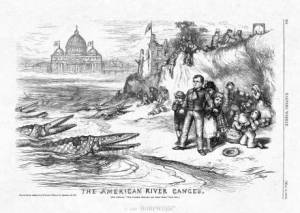
He consistently drew Irishmen as semi-human gorillas, never far from a whiskey bottle and shackled to political mahcines. (The fellow with the whip is Peter B. Sweeny, famed chieftain of New York’s Tamman Hall from the Boss Tweed era.)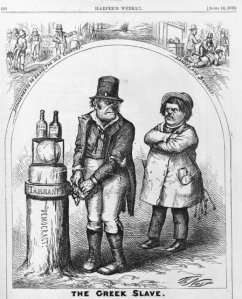
And for political enemies like Tweed, he considered capitol punushment just fine:
Why James Garfield over LBJ and the Adamses?
January 24, 2009 at 6:21 pm | Posted in -- C-SPAN presidents poll, David McCullough, David Stewart, George W. Bush, Gerald Ford, Harry Truman, James Garfield, John Adams, Joseph Keppler, Lyndon Johnson, Paul Giamatti, Vietnam | Leave a commentSince I posted my Presidential rankings for the C-SPAN 2009 Historians Survey a few days ago, I’ve received pointed questions from friends about some of my choices. (See January 18 post below.)
For instance, how could I put Gerald Ford so high on the list, in the top ten, for God’s sake? And what was I thinking in ranking James Garfield, who served only four months before being shot in the back, above LBJ and both the Adamses? And, in putting George W. Bush at the near-bottom (#41 out of 43), wasn’t I just following a liberal fad that will disappear in a few years, much as Harry Truman has gained popularity over time. 
Over the next few days, I will tackle each of these. Yes, Gerald Ford deserves his high spot. Yes, James Garfield outranks LBJ, John Adams, and John Quincy. And no, George W. Bush’s bottom status is no passing liberal fancy. Bush is no Harry Truman. He will be considered as much a bottom-feeder a century from now as today.
I’ll start today with James Garfield, only because this was the first challenge to come up. Stick with me on this.
The basics are simple: James Garfield, a Civil War veteran and career Congressman, was elected President in 1880, inaugurated in March 1881, shot by Charles Guiteau four months later, and died about two months after that. He was mourned by hundreds of thousands, respected for confronting political bosses, and credited with the modern Civil Service system adopted after his death.
During his term, he prevailed over Sen. Roscoe Conkling, dictator of the NY Republican machine, is a high-profile brawl over abusive patronage peddling. His Secretary of State, James G. Blaine, started the country on a strong foreign policy that culminated in TR’s “big stick” approach twenty years later. Here is my favorite cartoon of him, by PUCK artist Joseph Keppler, showing Garfield accepting the surrender of Ulysses Grant at the 1880 Repiblican Convention after Grant’s 3rd term movement collapsed on the 36th ballot:

It was my friend David Stewart, author of that terrific book THE SUMMER OF 1787: The Men who Invented the US Constitution, who blew the whistle on me. “Whoa, big fella!,” he wrote, knowing of my own book about the Garfield assassintion, (DARK HORSE). ” James Garfield ahead of Lyndon Johnson and both Adamses? We’re dishing out some home-cooking here. Remind us again, what did Garfield do as president?”
Good question. So let’s deal with it directly.
Ranking presidents means mnaking choices. James Garfield’s presidency had only a small impact because it was so short. Even giving him maximum credit, he stand mid-pack, slightly above center, which is where I ranked him, at #18.
Now let’s lkook at the competition.
Lyndon Baines Johnson? We can start and end the conversation with one word: Vietnam. I don’t recall James Garfield ever going out and getting the country stuck in a full-scale land war half-way around the world, commiting half-a-million troops to the effort, most unwilling draftees, all based on bad intelligence and bad advice, then misleading the country as tens of thousands died, then allowing the war to spin out of control and destroy his domestic agenda, causing the country then to react by electing an even worse leader in Richard M. Nixon.
This is LBJ’s legacy. Yes, he had a sterling record on Civil Rights and passed a boatload of Great Society legislation. But his own Democratic Party was ready to kick him overboard when he declined to run for re-eleciton in 1968. Without his Civil Rights record, Vietnam easily would have sunk LBJ to the bottom half of the list. As is, I gave him much credit for his domestic agenda, with an overall rank of #19. I think he owes me a “thank you.”
Then there are the Adamses. Let’s start with John Adams, the second president, serving from 1797 to 1801, the first to be voted out of office. Yes, he came across wonderfully in that terrific HBO miniseries where he was play by the fine actor Paul Giamatti, based on the terrific biography by David McCullough. And yes, John Adams was a sterling patriot and fine man during most of his life.
Still, his presidency was a sorry mess. Its emblem was the Alien and Seditions Acts. I do not recall James Garfield ever pushing Congress to pass a law allowing him to throw dozens of newspaper editors in jail for the simple act of publicly opposing his foreign policy, as well as locking up large numbers of immigrants on trumped up claims of disloyalty — as did John Adams. The abuse was flagrant.
Adams showed his bad temperament again after losing re-election in 1880 by refusing to act civilly toward Thomas Jefferson, the person who beat him, at Jefferson’s 1881 Inauguration. I rated Adams the best I could given a bad record. He ranked #31 on my list, just above Rutherford Hayes and William Howard Taft. Once again, I am ready to accept a “thank you” note from the Adams family.
Finally, there is John Quincy, whom I rate well above his father at #25, though still mediocre. Another fine man;l another disappointing president. From the moment he entered office, his politicasl opponents branded his Administration the product of a “corrupt bargin,” and for four years the albatross stuck, fair or not.
That’s them explanation. I am very comfortable with where I’ve placed James Garfield, notwithstanding LBJ and the Adamses. Tomorrow, I’ll talk about Gerald Ford.
Thanks for listening. –KenA
Create a free website or blog at WordPress.com.
Entries and comments feeds.
